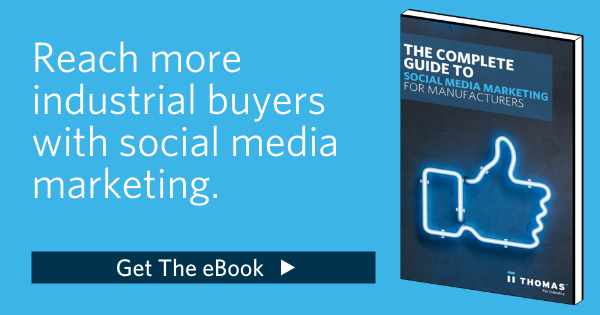4 Steps to Expanding Your Industrial Network on LinkedIn
Brittany Asciolla June 15, 2022
Chances are you’re already using LinkedIn to keep an up-to-date roster of contacts, check out what connections are up to, scout out potential hires, and send messages.
This powerful tool serves as much more than a social network or recruiting outlet, though — it can play a major role in generating leads and sales for your industrial company.
There are a few steps for you to benefit from using LinkedIn to connect with people in their industry, so we wanted to lay out a few tips on how to get started.
(We do want to note that although there's a paid version of LinkedIn known as LinkedIn Sales Navigator, we know you’re as budget-conscious as you are business-savvy, so we’ll be solely focusing on harnessing the power of free LinkedIn in this post.)
Step One: Revamp Your Profile
Your LinkedIn profile is much more than just a copy of your résumé — it should serve as a more personal, in-depth overview of what you do and how you can benefit people considering working with you.
LinkedIn makes it super easy to fill in fields that make you more searchable to prospects. You'll get reminders of additional information to add — and you'll even be able to see the "strength" level of your profile, which will increase as you add more information and connect with more people.
As you start to pull together your old job descriptions and list of associations you're involved in, don't forget a few important basics.
Grab Attention With Your Headline
Don’t limit yourself to just your job title here. Use this as an opportunity to present an active, pithy description of what you can offer to your prospects. Yes, you're officially the "President of X," but you're also an engineer, pharmaceutical industry leader and green manufacturing expert, so feel free to include it. (Again, makes you much more searchable!)
Thomas President and CEO, Tony Uphoff is more than Prez and Chief Executive Officer.

Include A Professional LinkedIn Photo
It may seem silly, but people with pictures get 40% more responses to messages than people without. We know you love your dog, sports team, and family, but keep it to a professional headshot here and save those other photos for Facebook.
Provide The Best Way To Contact You
Listing your email address, telephone number, and other social media links here easily allows people to reach out through their chosen means. Not everyone's comfortable having a back and forth about spec sheets through LinkedIn messaging, so make sure you have other ways to get in touch.
Update Your LinkedIn Profile URL
This isn't a game-changer, but it's good to have a personal, clean URL for your personal brand. Plus, when you copy and paste the link, you won't get all of those weird characters — just your name and whatever else you designate.
(Bonus: This also makes life easy when you're updating your business cards.)
Showcase Your Expertise In Your Summary
Don’t overdo it here — a clear, direct, and engaging description of your background and expertise will help people understand your skills and goals and why they should work with you. Use keywords to hone in on your specific industry, and cite specific results and accomplishments. End with a call-to-action (CTA) that tells people how to get in touch.
Increase Engagement With Work Samples
Posting a few pieces of content (case studies, project galleries, etc.) will get your profile viewers engaged with your work — and over to your company website.
Land Your Dream Customers By Displaying Experience
Keep your dream customer in mind here. What would they want to know about your experience? A few bullet points for each position should describe you solve your customers' problems, as well as illustrate solid results.

Show Your Education
Besides listing formal degrees, showcase any certifications you’ve received or online courses you’ve completed.
Step Two: Use Groups & Connections to Your Advantage
LinkedIn is a hub of conversations; you can find a group for just about any industry or interest.
There are thousands of industrial options to choose from, but you can only join up to 50, so spend some time searching for what brings the most value to your business.
Once you’ve joined, scan through the list of members and use search filters such as job title, location, and company name to narrow down your best bets for leads. It's also a great place to start conversations with folks, and there are a lot of other opportunities here.
Make use of your 2nd and 3rd connections — people you share 1st or 2nd connections with but are not directly connected to yourself. Using your 1st connections as a means of introduction will give you credibility.
Then send personalized invitations to connect to these prospects; people will not be interested in a generic message from someone they don’t know.
Start out with a quick introduction, why you want to connect, how you found them, and how you can be of service to them. Better yet, mention a shared interest (look under their hobbies, education, and volunteering for ideas) or a post they commented on in a group.
Step Three: Share Useful, Compelling Content

Rather than posting promotional, sales-related content to your groups, share valuable information with them, allowing them to really take notice of your expertise.
Any content you share should be catered to a specific industry focus — sharing relevant articles and case studies will foster discussion and position you as an expert, not just someone out to ramp up their own business.
And when sharing content, be sure to pen an eye-catching, direct title that will make people want to read further.
Bonus: Use the 50/30/20 rule on social media. Here's The Right Mix Of Social Media Content For Manufacturing Marketing.
Step Four: Create Your Own Group
Once you’ve established a presence in existing groups, creating your own will not only further establish you as a leader and person of knowledge, it will also allow you to reach out to members directly via email. It's important to note that this group should not be a "fan page" for your company — but a place where your prospects, colleagues and members of the industry can share ideas or information.
Narrow down who you want to invite by honing in on the industries you want to target, deciding what size company you’re focusing on, and, if applicable, your geographical reach. Searching by job title, focus on active users who are likely to see and respond to your content.
Your list should be broad enough to reach a range of professionals but narrow enough to generate truly promising leads (think around 2,000-3,000 people). This process takes time, yes, but it’s invaluable for connecting with members of your community.
Although the group itself should not be entirely self promotional, you can start a messaging campaign for your company once the group picks up steam. These messages should be personalized, relevant, and never promotional — just as they are when posting within your group or others. Pointing people to group discussions that may be of interest to them is a great place to start, or sharing interesting industry articles. From there the relationship can grow naturally.
Final Thoughts
LinkedIn plays an increasingly integral role in industrial lead generation. By mastering these few simple techniques, you can quickly establish leads and help increase sales for your company. Interested in more details? Learn how to to effectively engage with your network on your other social media platforms with help from our guide, Social Media Marketing For Manufacturers.
Did you find this useful?










